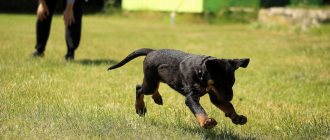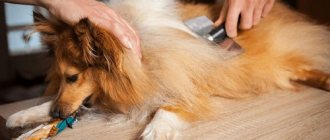Walking a pet is a mandatory procedure, during which it gets to know the world around it, gets to know its fellow pets, relieves itself and develops physically. But what should the owner do if the dog is afraid to walk outside and every exit from the house turns into a tragedy? The dog hides in the far corner, the owner gets nervous, begins to drag him out the door by force, and as a result, both the furry friend and his “leader” are in a bad mood. The article will analyze in detail the fear of a four-legged fidget associated with going for a walk, and will also propose effective options for getting rid of such a phobia.
Reason #1: feeling unwell
Refusal to walk can be the same symptom of health problems as fever or vomiting.
So, the reason may be that it is generally difficult for the dog to walk and move; his paw may hurt, for example. Then it is necessary to examine the dog for injuries and wounds.
If the state of apathy and lethargy is accompanied by other symptoms, then you should immediately consult a doctor.
Common Mistakes
Walking puppies that are too young and have not undergone the first vaccination can lead to infection and even death if they come into contact with other dogs. Such babies can only be walked in your arms.
Attempts to calm a puppy showing signs of panic (plaintive whining, tucking its tail, trying to retreat into the bushes, trembling all over the body). Soothing stroking and coaxing will be perceived by the puppy as praise for this behavior. To prevent a repetition of the situation, you need to fraudulently lead your pet to the object that frightened it and convince it of its safety. If the puppy obeys and behaves calmly, you should praise him and give him a treat.
Reason #2: There's something scary outside
Dogs may feel uncomfortable outside if they are afraid of something. Anything can scare them: from fireworks to a simple passerby. Puppies that are not yet sufficiently socialized are especially susceptible to new things.
If a dog is drawn towards the house, refuses to go, or has its tail between its legs, then most likely it is afraid of something. In this case, under no circumstances should you force the dog. This issue needs to be approached delicately.
Try to remember or figure out what scared the dog. When you determine the cause of the fear, begin to carefully take the dog outside: be patient, use other routes, praise the dog, give it treats and do not shout or get angry under any circumstances.
If the fear does not go away or progresses, seek advice from an animal psychologist.
Disease
Domestic dogs are completely dependent on the daily routine and pace of life of the owner. Thanks to the ability to adapt, within a short period of time, the dog’s body begins to work at a “comfortable” pace for it. It is thanks to this feature that adult pets tolerate going to the toilet and do not feel acute hunger between feedings.
Most owners whose dogs suddenly refuse to go for walks immediately suspect illness. There is some truth in these suspicions, especially if the dog has suddenly become apathetic.
The first thing to do if the dog refuses to go for a walk is:
- Superficial inspection - we check the condition of the fur, skin, paws, claws, eyes, ears, mouth.
- We examine the mucous membranes.
- We check the temperature of the mucous membranes and body.
- We monitor your appetite and drinking regime.
- We palpate the joints and abdominal area of the dog.
Reason No. 4: fatigue and lack of mood
No matter how it sounds, dogs get tired too and they may also not be in the mood for long and enjoyable walks. This may also be due to general fatigue, for example after a visit to the veterinarian or from long games or lack of strength.
To keep your dog in good shape and help it replenish its strength and energy, it is important to feed your pet properly.
For example, Dog Chow® food is great for active dogs. A complete diet made from natural ingredients will give your pet energy and restore strength. The composition includes a natural prebiotic that helps improve digestion. The brand's diets do not contain artificial colors, flavors or preservatives. You can find out more about the food by following the link.
Individual, related to external factors
The influence of weather conditions is no less important: temperature, wind speed, humidity, excessive dryness. During the cold winter months, animals often find it uncomfortable to walk because they are cold. During the hot season, dogs often feel ill on walks due to exposure to high temperatures. The weather affects all animals differently: some are comfortable in certain conditions, others are not.
Solution:
It is important to take into account the individual characteristics of the animal. If you have a dog without a thick undercoat that cannot tolerate frost, choose clothes for it in cold and wet weather. Also, increase your walking activity so that your pet does not have time to freeze. Do not allow the dog to chase cats and cats, but provide him with loads that will be associated with interaction with you. In another case, when the dog does not tolerate the heat well, reconsider the walking regime in the summer: walk early in the morning and late in the evening, when the sun is below the horizon.
Thank you for using the information from our article. We wish you and your four-legged dogs pleasant walks!
Reason #8: inconvenient ammunition
The simplest reason: a harness, collar, leash or clothing can cause discomfort. For example, they may simply be small and chafe. Often in such situations, the dogs themselves try to get rid of the inconvenience, then the owner needs to accept the situation and replace the equipment.
And remember that on walks it is important for the dog to be with the owner: this is the time you spend together. Pay attention to your dog’s feelings and yours - and let walks bring joy!
Add your petAsk questions to veterinarians and animal psychologists for freeDogCat
Why doesn't the dog want to go for a walk?
Walking is a necessary condition for keeping a dog, along with high-quality food and a comfortable bed (a large selection of beds and sofas for pets can be found here: https://willowandberry.ru/ - this is the website of Willow and Berry, a domestic manufacturer of beds for dogs and cats).
Regular walking is important for a dog, and not only because it can go to the toilet during a walk. On the street, your four-legged friend gets the opportunity to smell much more smells than at home, as well as communicate with his own kind and get some exercise. All this is necessary for the development of both the musculoskeletal system and the brain of your pet. If we are talking about a hunting or sledding breed, then the need to spend a long time in the air is literally in their blood. It is quite natural that the dog’s obvious reluctance to go outside becomes a cause of concern for owners who do not understand the reasons for the pet’s stubbornness. Let's look at why a dog may not want to go for a walk.
How to help a dog that is afraid of the street?
Get ready for long and hard work. An important stage of adaptation is the establishment of a trusting relationship between the owner and the dog. The pet must be confident that you are able to protect it, that you are an unshakable leader, but at the same time that you can be trusted. No matter how long this stage takes, without it you will not move from the “dead point”.
Important! When a dog shows panic, he should not be calmed! In the eyes of the mentee, this looks like praise for inappropriate behavior.
Seeing that the puppy is afraid of a specific object, for example, a large box or a car, use cunning to lead the dog to the “enemy”. Show that the scary object is not dangerous. When training a dog at home, it is allowed to beat the “enemy” or destroy it. Make a cardboard model of the car and give it “the first number” so that it is discouraging to scare your ward.
The dog is gradually accustomed to the sounds of the outside world and bright light, carrying the ward in his arms (if dimensions allow). If your pet is of impressive size, start walking on the balcony or near an open window.
A painful reaction to bright light indicates a low rate of pupil constriction or a more serious nervous pathology. The same violations may be the root cause if the puppy is afraid to walk at night. The pupils should dilate in the dark and contract in bright light; disruption of these functions leads to temporary blindness, which instinctively causes fear.
Socialize your puppy outdoors
When you move your training session outside, remember that being outdoors can be a stressful event for your puppy.
All the sights, sounds and smells can be overwhelming. Proper socialization will help combat your puppy's anxiety and build confidence.
Introduce your puppy to people of all shapes, sizes and nationalities. Don't forget about all the ways humans can be different from dogs, such as glasses, wheelchairs, and hats.
You should also expose your puppy to a variety of different dogs and environments. However, you should not force these meetings. Let your puppy initiate contact and move at his own pace.
Maintain a positive attitude and combine new outdoor experiences with games, praise, and treats.
This will help your dog become accustomed to the world and see other people and dogs as friends rather than threats.
Tips for walking your puppy
If you still can't get your puppy to move on a leash, try these techniques:
- Take the puppy 20 or 30 meters from the house and let him return on his own. Your puppy will experience the same feeling as leaving the house, but knowing that he is returning to a safe place will encourage him to keep going.
- Drive the car with the puppy a block or two away from the house and walk the puppy back into the house.
- Travel to a new place. A different neighborhood, a quiet park, or a dog-friendly pet store are all ideal places for your pup to socialize. Plus, not having a home in sight can help your puppy explore rather than retreat.
- As a reward, choose an expensive treat or toy that your puppy will only receive during a walk. Your pup will want to go for a walk to earn that special treat.
- Enroll in a positive dog training class. This is a great way to socialize with your puppy, and you will also receive practical help tailored to your puppy's specific needs.
Whatever techniques you use, stay positive while walking. Your puppy will sense your emotions, so if you become worried or upset, it will affect your puppy's perception of the experience.
Unsuitable weather
Just like people, pets do not like to go outside in bad weather. Moreover, not only memories of the previous wet and cold walk can affect, but also the mood of the owner. If you try to take a walk as quickly as possible in bad weather or even stand near the entrance, waiting for the dog to do its business, do not be surprised that at some point the pet will refuse to go out in the rain and will remain at the entrance door.
One of two things: either you walk as you should, even in bad weather, follow your usual route, or you stay at home and go for a walk when it clears up. Take care of your dog's clothes: perhaps your pet is just cold. In the rain, by the way, you can have fun at home, for example, create an obstacle course from improvised objects or play tug of war.
Teach your puppy to love a leash
Some puppies are easy enough to walk on a leash. A leash is a form of restraining his capricious desires. When you take your puppy out on a leash, they can't go wherever they want or run away from anything that scares them.
But first you need to accustom the puppy to a leash and collar.
Because many puppies are scared by a leash. Instead of seeing the leash as a sign of an exciting walk, puppies are afraid of it.
Even a collar can upset some puppies.
Moreover, if you use the collar to grab the puppy and pull him, this will be associated with negative consequences.
If you want your puppy to enjoy his collar and feel comfortable, then read the article linked above or the quick tips below.
Typically, the breeder will introduce your puppy to a collar and leash. But if not, your job is to help your puppy feel confident in them. Start in the house for short periods of time.
Praise and play with your puppy while he is wearing it, and feed him tasty treats as a reward.
Then the puppy will see in the collar and leash a prediction of wonderful things and treats.
Now you are ready to teach your puppy to walk on a leash.
While still in the house, use treats to lure your puppy towards you while he is on the leash. Praise and reward your puppy when he comes to you.
Then start taking your puppy for walks. If your puppy is hesitant, tempt him with treats.
When your puppy is walking around the house with you, try walking around the backyard before moving onto the sidewalk. Keep sessions short and provide frequent praise and encouragement.
It's boring to walk
Active dogs that love to run and explore may stop loving walking if they walk the same route every day exclusively on paths. Even if they don’t refuse to leave the house, getting ready for a walk is perceived without much enthusiasm and willingly turns back.
In this case, it is imperative to diversify street activity. Dogs that do not fully satisfy their hunting instincts can become depressed, get sick, and change their behavior beyond recognition (become uncontrollable and irritable). Try to take a new route each time. Play outdoor games with your pet even in winter.











